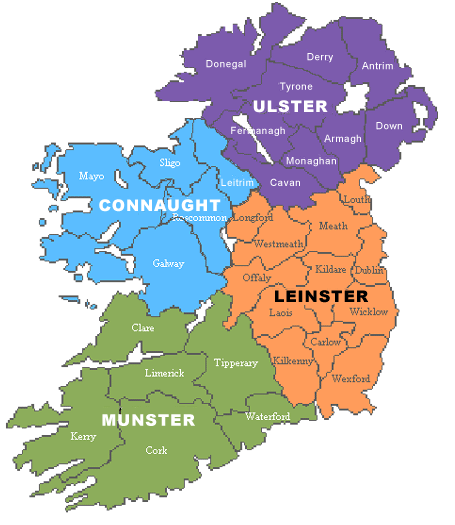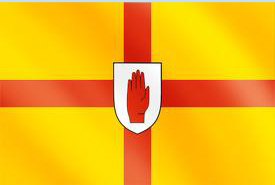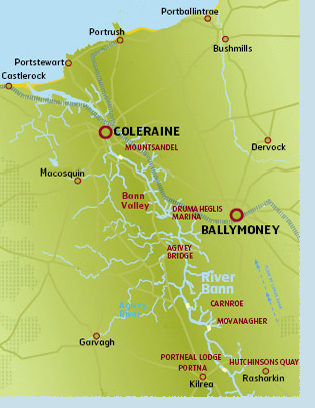

 Ulster is one of four provinces that make up all of Ireland and is in the northernmost part of that country. Ulster has nine counties, six of which make up modern day Northern Ireland, the other three remain part of the Republic of Ireland.
Ulster is one of four provinces that make up all of Ireland and is in the northernmost part of that country. Ulster has nine counties, six of which make up modern day Northern Ireland, the other three remain part of the Republic of Ireland.
In the very early 1600s, King James I, of England, began a massive repopulation of Ulster with mostly Scottish and English Protestants. The area was at the time largely occupied by indigenous people and their powerful overlords, who had been defeated and depleted in various rebellions with the crown during the reign of Queen Elizabeth. This forced plantation, much of it by private means, was an effort by the king to colonize this here-to-fore troublesome area with a more sympathetic and supportive people. This population was largely increased with further immigration over the next fifty years as a result of persecutions at home by English Kings Charles I and Charles II in their effort to establish the Church of England in Scotland in place of the Scottish Kirk established earlier that century.
With this repopulation of Ulster, came several families with the surname Jam?son. Our particular Jameson family was one of these.
Apart from an undocumented story about a William Jameson's involvement in the 1690 Battle of Boyne and a few other records, here and there, very little else is known about these early Ulster Jameson families. Although research on Jam?sons in early, pre 1750, Ulster has apparently been sparse, what has been done shows most Jam?son families of that time seem to have been concentrated in the northern counties of Antrim and Londonderry - from Belfast northwestward to Londonderry city. Unfortunately, many of the early (1600s and 1700s) records from this area, were lost in a 1922 Dublin fire. Those that do remain are mostly reconstructions from a collection of various local church, municipal and some miscellaneous other records.
One group of surviving records are the 1630 Muster Rolls, which show two Jamesons in the northwestern section of County Antrim on the eastern side of the Bann River Valley and two others in the City of Londonderry in that county. This is important because, even though these records are probably incomplete, it does show a very early Ulster Jameson presence.
There are also the reconstructed Hearth Money Rolls of 1660's. These are records of taxes levied on families and based on the number of household fireplaces. Of these there are twenty two Jameson families listed in County Antrim, thirteen on the eastern banks of the Bann River, four of which were close to Coleraine and four in County Londonderry, two on the western banks of the Bann River in Coleraine Parish. Amongst these Jameson families are many with the familiar given names we recognize in our Colonial American Jameson immigrants, including Alexander, John, Thomas, etc. Any one of these could easily be our ancestors. In fact, the 1669 Hearth Money Rolls for Antrim show both an Alexander and a Thomas Jamesone in Ballymoney, County Antrim, right where our Hugh Jameson was listed in the 1740 Protestant Householder's Returns, suggesting this as our immigrant Jameson's earliest homelands in Ulster, or at least, their homelands around that time in history.
Scott Jameson wrote in his genealogy, a section he calls "The Argyle Jamesons" about his research on the subject of these Ulster Jamesons in Nutfield. Although this work is no longer available on line, we have added a little of it here as background. "From this area of the Bann Valley came several Jamesons who migrated at various times and settled, coincidentally enough, in Nutfield, New Hampshire: Jonathan Jamison, prior to 1725; William Jamison, prior to 1733; Thomas Jamison, 1746; Hugh Jamison, 1746; Alexander Jamison, prior to 1746; and Elizabeth Jamison Boyd Woods, 1746. The latter four were from the area around Coleraine, while Jonathan Jamison was from Kilrea where a brother, Edward, lived as a farmer." There have been several other Jam?sons discovered to have emigrated from this area that not all of these families are related. In fact most, apparently, are not - at least not genetically.
 The Bann River Valley area of Ulster is one of the oldest human settlement areas in Ireland, thought to date back to the end of the last glacial age. The Bann River, the longest river in Northern Ireland, is often referred to as the dividing line between the east and western parts of Northern Ireland. The town of Coleraine in the northern part of the valley, near the mouth of the Bann River and close to the Atlantic Ocean, is one of the oldest cities in all of Ireland dating back to the time before the Picts and is said to have gotten it's name from Saint Patrick himself, who built a church there. Coleraine had been the main town of County Coleraine, which became part of County Londonderry in 1613 when Ulster began it's repopulation by the English using commercial Plantations.
The Bann River Valley area of Ulster is one of the oldest human settlement areas in Ireland, thought to date back to the end of the last glacial age. The Bann River, the longest river in Northern Ireland, is often referred to as the dividing line between the east and western parts of Northern Ireland. The town of Coleraine in the northern part of the valley, near the mouth of the Bann River and close to the Atlantic Ocean, is one of the oldest cities in all of Ireland dating back to the time before the Picts and is said to have gotten it's name from Saint Patrick himself, who built a church there. Coleraine had been the main town of County Coleraine, which became part of County Londonderry in 1613 when Ulster began it's repopulation by the English using commercial Plantations.
E.O. Jameson, like many others, including Scott, though that the father of these Jamisons was one William Jamison, a Presbyterian Scots-Irish, whose family emigrated to Ulster from Argyleshire, Scotland around 1612-19. William Jamison Sr. served during the Siege of Londonderry in 1689. However that doesn't seem like it may have been the case, at least not with all of the Jamesons in the Bann River Valley region. Recent research shows that of the many different Jam?son families from that area, not all are related. This has now been proven, beyond any doubt, with YDNA testing. Scott himself tested as not a match with those tested from the Hugh and Thomas Jameson family. This would then prove these ancestors were not all related, particularly his William, and those ancestors from that side of the family can not be shared. Other Jam?sons from that same region have also tested differently. In fact most, apparently, are not - at least not genetically.
We don't know very much about our early Jamesons or exactly when or how they came to this area of Ulster around Coleraine and the Bann River Valley, only that they were there in at least the early 1700s, probably before. We know they came from Scotland before that, perhaps from the Midlothian area near Edinburgh, see here. There is evidence of other Jam?son families in all of Ulster, including several Jam?son families in the Ards Peninsula and in Belfast, easily going back to the early 1600s. We also know of Jameson families of this era in Londonderry area and on many other ares along the north east coast of Ireland. Perhaps our family were one of these before migrating to the Bann area. Either way, this is the only place, so far, we find any early provable evidence of them. Any of this is possible, even likely.
Nor do we know very much about our particular Jameson family during the time when they were living in the Bann area of Ulster, before they began leaving, during the first half of the 1700's. Or, for that matter, do we know very much about any of our Jameson families that may have remained in Ulster after our immigrant ancestors, left Ireland. We do know that at least some in our family were from the area around Coleraine and other parts of the Bann River valley area in the northwestern most parts of County Antrim and the northeastern parts of County Londonderry. We also know about several of our Jameson families that emigrated to early New England of which at least our two, Thomas and Hugh sailed from Portrush on the northern coast of Ireland not far from Coleraine. It is also known that many of the other families that can be found in early Colonial New Hampshire, amongst our Jameson immigrants, can also be found in the Bann River Valley of that time. Names like Cochran, Boyd, Rogers, McHenry, Taggart and so may others. In fact, it is said that the ship "William," with Archibald Hunter master, sailing from Coleraine (April or May), arriving in Boston (August 4-11, 1718), carried what became the Nutfield founding families.
Following is a little about those we do know about.
Jonathan Jameson is thought to be the oldest and most likely the first of our Jameson family to have immigrated, arriving sometime prior to 1725, He may have been with some of the earliest of those who left the Bann Valley for New England in 1718. He was a cousin of Thomas, Hugh and Alexander, who also came to New England, and was a brother to Edward, who remained in Ireland or perhaps Scotland.
Thomas Jamison sailed July 26, 1738 on board the ship "Lime" from Portrush, Ireland. The ship arrived November 16, in Boston, of that year, commanded by Captain Gabriel Black. There were 123 immigrants of whom nineteen were named: Thomas Jamison, Nathaniel Furber, George Marshall, William Leus, William Cox, Alexander Nesmith, Abraham Weir, Archibald Fullerton, Alexander Caldwell, William Dickey and his wife, David Griffin, Robert Griffin, John Arbuckle, George Robinson, Thomas Galt, George Galt, John Ball, and Mary Smith."
It is not known when Alexander Jameson left Ulster. He is mentioned in Jonathan's 1741 will as a cousin, implying he was in Londonderry, New Hampshire, so it is thought he may have possibly arrived with Thomas in 1738. Little or nothing else is known about the Alexander Jameson, apart from what is found in his cousin Jonathan's 1741 will. We don't know if this Alexander was a brother to Thomas and Hugh Jameson or if perhaps he was their father.
On August 4, 1746, Robert Parkinson with Hugh Jamison and Esther Woods, all were aboard the ship "Molly" when it left Port Rush, Ireland. They arrived at Boston, sometime in the early fall of that year.
It is known, that Hugh Jameson, Thomas Jameson, Alexander Jameson, Elizabeth Jamison Boyd Woods, and three Jameson daughters, sisters of the above people, were brothers and sisters. They were also first cousins to Edward Jamison of Kilrea, Ireland whose brother, Jonathan, emigrated prior to 1725 and settled in Nutfield.
It is known that Jonathan, Thomas and Hugh were cordwainers (shoemakers - historically, those that made shoes) by trade in New England. It is also known that Hugh Jameson was a cordwainer in Coleraine before leaving Ulster in 1746. Clearly, these Jamesons were a family of cordwainers.
There are and have been other Jamesons in Coleraine and the surrounding Bann Valley since. In fact there are Jam?sons to be found all over Northern Ireland. Unfortunately we know very little about how any of them might be connected with our early colonial immigrant New Hampshire Jamesons. We do however, know about some of them and their connections with our family/
Edward Jameson was a brother to Jonathan, both are thought to have been born in Scotland and may or may not have lived in Ulster, Ireland. Edward is said to have had ten children. His eldest son John lived in Balleystrone, Dunboe (Dumbough) Parish, County Londonderry, where he was a farmer and who, as far as we know, remained in Ireland. Unfortunately, very little is known of this Edward or John Jameson. Several other Jameson families can be found in the Movanagher (Kilrea Parish) area in the latter part of the 1700s and throughout the 1800s. Some of these Jamesons are known to have emigrated to America during the famine years. Fortunately, a few connections are now being made with our Jamesons from these earlier times.
One of these other Jamison families from our larger particular Jameson family who emigrated here from that same area of the Bann Valley, is the William and Jane Jamieson family, who arrived in Philadelphia May 1, 1851, with their three sons, Jonathan, William and Alexander. They settled in Western Pennsylvania around Pittsburgh. Although the parents William and Jane seemed to have died soon after arrival, the boys all thrived, all served in the Civil war and their descends now live all over the United States. We know this family is directly connected with the rest of our family because we know they were living in Movanagher (Kilrea Parish), Ireland, at the time they left Ulster and because they are a direct genetic (Y-DNA) match with others in our family who have tested. We assume this Jamieson family is part of the group who stayed behind when several of our Jameson family left Ulster in the early 1700's, probably descendants of the Edward Jameson listed above, however, we are not sure exactly how they are connected with the rest of us.
There is also have a Jamison family from the Holywood area of Belfast, County Down, in the latter 1800s who is a direct genetic (Y-DNA) match with descendants of our New Hampshire Jamesons. Although we don't yet know how this connection is made with the rest of our Jamesons, it is a promising indication of a larger family relationship still existing in that part of Ireland.
There are also an increasing number of similar, if not yet exact, genetic (again Y-DNA) tests, mostly coming from the Midlothian area of Scotland (around Edinburgh). This suggests a possible area from where our Jamesons may have been, before Ulster. Further research will be needed to determine this and any other family connections.